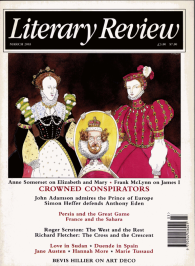Christopher Bray
A Visionary Victorian
Motion Studies: Time, Space and Eadweard Muybridge
By Rebecca Solnit
Bloomsbury 320pp £8.99
THE EXACT POSITION of a horse's four legs at any given moment during a race; the beery spume of water gliding over rocks; a couple locked dead still in an embrace, while behind them the city's frantic whirl goes on: photography is miraculous, in that it grants us visions of what the eye could not otherwise see. But photography is malign too, in that it encourages us to stop seeing at all. Show me a professional photographer and I will show you someone for whom life is an abstraction; show me an amateur photographer and I will show you someone letting life pass them by. So quickly can a tourist move from snapping one vista to another, from one monument to another, that nothing is actually witnessed: photography is a kind of aesthetic false-memory syndrome.
None of which is to denigrate the achievements of Eadweard Muybridge, the subject of Rebecca Solnit's fearsomely learned book. Muybridge was one of the great inventors of the Victorian age, but even had he not been a pioneer of photography and a key player in the development of motion-picture technology,

Sign Up to our newsletter
Receive free articles, highlights from the archive, news, details of prizes, and much more.@Lit_Review
Follow Literary Review on Twitter
Twitter Feed
It wasn’t until 1825 that Pepys’s diary became available for the first time. How it was eventually decrypted and published is a story of subterfuge and duplicity.
Kate Loveman tells the tale.
Kate Loveman - Publishing Pepys
Kate Loveman: Publishing Pepys
literaryreview.co.uk
Arthur Christopher Benson was a pillar of the Edwardian establishment. He was supremely well connected. As his newly published diaries reveal, he was also riotously indiscreet.
Piers Brendon compares Benson’s journals to others from the 20th century.
Piers Brendon - Land of Dopes & Tories
Piers Brendon: Land of Dopes & Tories - The Benson Diaries: Selections from the Diary of Arthur Christopher Benson by Eamon Duffy & Ronald Hyam (edd)
literaryreview.co.uk
Of the siblings Gwen and Augustus John, it is Augustus who has commanded most attention from collectors and connoisseurs.
Was he really the finer artist, asks Tanya Harrod, or is it time Gwen emerged from her brother’s shadow?
Tanya Harrod - Cut from the Same Canvas
Tanya Harrod: Cut from the Same Canvas - Artists, Siblings, Visionaries: The Lives and Loves of Gwen and Augustus John by Judith Mackrell
literaryreview.co.uk